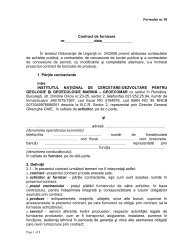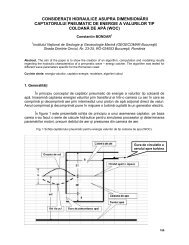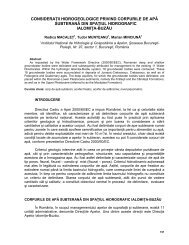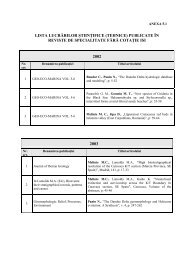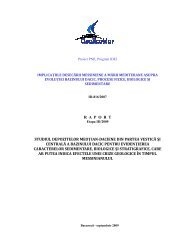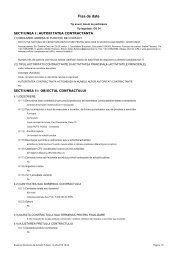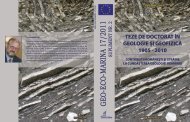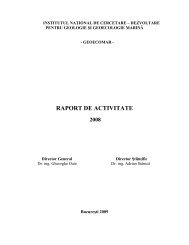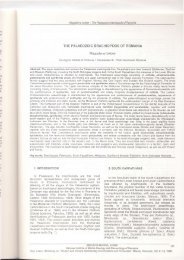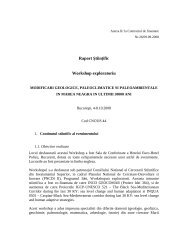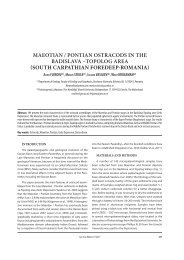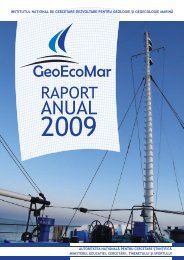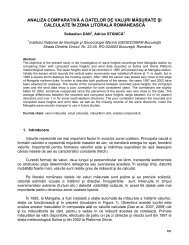DACIAN BASIN - GeoEcoMar
DACIAN BASIN - GeoEcoMar
DACIAN BASIN - GeoEcoMar
Create successful ePaper yourself
Turn your PDF publications into a flip-book with our unique Google optimized e-Paper software.
150<br />
Chapter 6. Upper Neogene Fluvial Sedimentation in the Dacian Basin<br />
6.2.2. Fluvial environments in the Dacian Basin<br />
One of the best known classifications of the fluvial sedimentary facies considers<br />
the following genetic categories (Galloway and Hobday, 1983):<br />
■ fluvial channel facies and<br />
■ out-of-channel facies.<br />
The out-of-channel environment includes:<br />
» sediments accumulated near the fluvial channel (levees and crevasse splays);<br />
» sediments accumulated away from the channel (fluvial floodplain).<br />
The Dacian Basin fining upward units described in this chapter constitute the<br />
facies of the sediment accumulated in the fluvial channel. Certain sedimentation processes<br />
(disturbance of the fluvial channels, erosion immediately after sedimentation,<br />
advanced sorting of sand sediments etc.) restrict or modify the fining upward trend<br />
of the channel-fill deposits, which leads to the apparition of distinct types of grain<br />
size grading in the deposits of the fluvial channel.<br />
Well log analysis shows that Middle Dacian – Romanian channel fill deposits are<br />
thick (10 - 20 m) and numerous. Many channels are discrete, separate bodies (Fig.<br />
6.16 A) with fining upward trend. The non-graded channel fills (cylindrical pattern<br />
on the well log) are infrequent (Fig. 6.16 B). Some channel fill units are superimposed<br />
(Fig. 6.16 C), but this is not a dominant feature. Clayey, flood plain deposits<br />
separate the channel fill, sandy deposits. The well logs reveal the existence of coarsening<br />
upward alluvial cycles (Fig. 6.17 E) in the Middle Dacian. However, this trend<br />
is not common in the fluvial Pliocene sequence.<br />
Images based on log data from a detailed hydrogeological wells network, supplied<br />
information on the geometry of fluvial channels in the Pliocene to Quaternary time<br />
(Jipa et al., 1999) (Fig. 6.17). The reconstructed channels are large features, up to several<br />
kilometers wide (between 300 m and over 4 km, especially between 1.5 and 2 km). The<br />
smallest channel sections are several hundreds of meters in width. The density of the<br />
channel system is remarkable. The individual fluvial channels have 5 to 25 m thick. No<br />
constant lateral switching trend emerges from the channel network reconstruction.<br />
Due to the spectacular exposures created by the mining activities in the coal<br />
quarries from Oltenia, the facies of the sediments accumulated on the edge of the<br />
channel (levees) was occasionally recognized. We attributed to this category the<br />
fine and very fine sands that are bounding deposits interpreted as channel-fill sediments.<br />
The channel levee deposits interpretation is supported by the position on<br />
the edge of the channel, and by the presence of fossil wood (tree trunks in growing<br />
position) found in these deposits (Fig. 6.18).<br />
The crevasse splay environment was identified in the fluvial deposits investigated<br />
from the Dacian Basin. The sediments of this fluvial environment occur as<br />
coarsening upward, fine-grained (silt to fine sand) sequences, with reduced thickness<br />
(decimeter to less than one meter).



